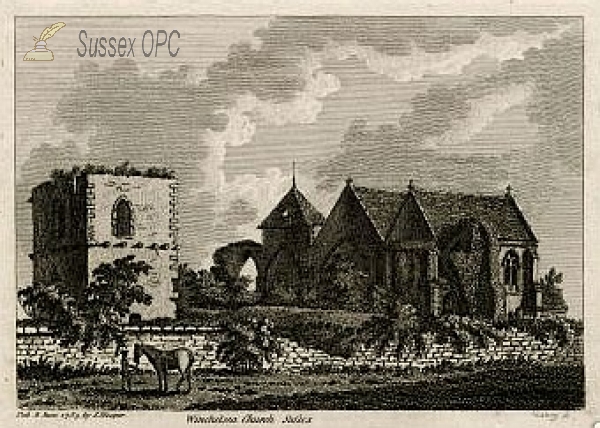St Thomas the Martyr, (Winchelsea)
Denomination:
Internet:
A Church Near You (Church of England site for this church).
Grid reference: 590500, 117350, View on: Google Maps, Open Street Map, Streetmap, National Library of Scotland Map, Magic Maps
Incumbents:
Incumbents of St Thomas Church
Registers:
Earliest Register: 1606.
Baptisms:
There are no baptisms in the OPC database.
No baptism IGI batches known.
Burials:
There are no burials in the OPC database.
No burial IGI batches known.
Marriages:
There are 150 marriages in the OPC database.
IGI Batches: M148132 (1606 ~ 1640); M148133 (1881 ~ 1893).
Monumental inscriptions:
There are no monumental inscriptions in the OPC database.
Images:
POWPics (The New Roughwood Church Album) contains 14 photographs of this church. This album will also display any postcards or other images of the church which are in the Sussex OPC database.
There are 34 images of this church in the OPC database.
Building information:
Current use: Worship.
Harrison's description (1911):
Restored in 1850 and 1905. Vestry restored and wall under belfry removed in 1911. This fine portion of a church is the best example of Dec. work in Sussex. The chancel with aisles and ruins of transepts alone remain. It is doubtful whether the church was ever completed; if it had been, it woudl probably have been cruciform with shingled spire. In the "Guide to the Parish Church," evidence is produced that the foundations of the nave at least were laid. With the exception of the late Perp. porch, by which the church is now entered, the building is entirely early Dec. The rich tracery of the large windows is peculiar, partaking of a Continental character. Note: on exterior, piscina in ruins of transept; flying butress; open tracery of parapet; fine vane; entrance to vaulted crypt; consecration cross at E. end of S. aisle. At S.W. was a detached campanile, pulled down in 1790.
The choir is separated from the aisles by three lofty arches with piers of fluted and banded shafts of Caen stone and Sussex marble alternately. The restored recesses, forming the sedilia and piscina, are richly canopied, lined with beautiful diaper work, and surmounted by crocketed gables and pinnacles. Note: the curious arrangement of quatrefoils in N. and S. windows; fine natural foliage; and well carved corbel heads in the building. The bracket in wall is supposed to have supported the figure of St Thomas à Becket.
The S. aisle (Alard and St Nicholas Chantry) contains the magnificent canopied tombs of the Alards. The finest is that of Gervase Alard, the first to bear the title of Admiral in England, c. 1300. The effigy is lying cross-legged with hands holding a heart and a lion at his feet; the cushions on which his head rests are supported by the mutilated remains of two angels; the beautiful diaper work, which lines the recess, has traces of colour. The second tomb is similar, though less ornate, and is supposed to be that of Stephen Alard, Admiral of the Cinque Ports in Edward II.'s reign. Note: niche in E. wall; alabaster tablet; piscina and sedilia; on the floor, a stone )brass gone) representing a man and woman, and smaller figures; stone slab, which has lost its brass, to Reginald Alard (1354).
In the N. aisle (the Godfrey or Farncombe Chantry and Chapel of B.V.M.) are three canopied tombs with effigies (entirely of Sussex marble) of a knight in chain armour, a lady, and a youth. It is uncertain whom they represent. They are of an earlier date that the church, and may have been brought from the church of Old Winchelsea. Note: figure head over the pillar opposite (?Henry III.); Crusaders' crosses on pillars; memorial window with some old glass.
There is an Elizabethan chalice. Font, modern.
Wesley's tree, where John Wesley, in 1790, preached his last open air sermon, is to the W. of the church.
In the private grounds, which occupy the site of an old Franciscan monastery, may be seen the ruins of the Chapel of the Blessed Virgin, founded in the early part of 14th c. It was in the Dec. style, and the chancel arch is very pleasing. The E. end was apsidal.
Note also the 13th c. Town Hall.
Documents:
There are no documents about this church in the OPC database. If you have one, please contribute a transcription!
Publications:
There are no books about this church in the Sussex OPC Bibliography.
There are no articles about this church in the OPC Sussex Archeaological Collections Index.
Interest in this church:
No registered users have badged this church yet. To share your interest with others, why not register as a frequent user of this site?
The advertisements below are served by Google; the very small revenue generated when people click on them sometimes covers the cost of hosting the Sussex OPC website.


 Sussex OPC Home
Sussex OPC Home






